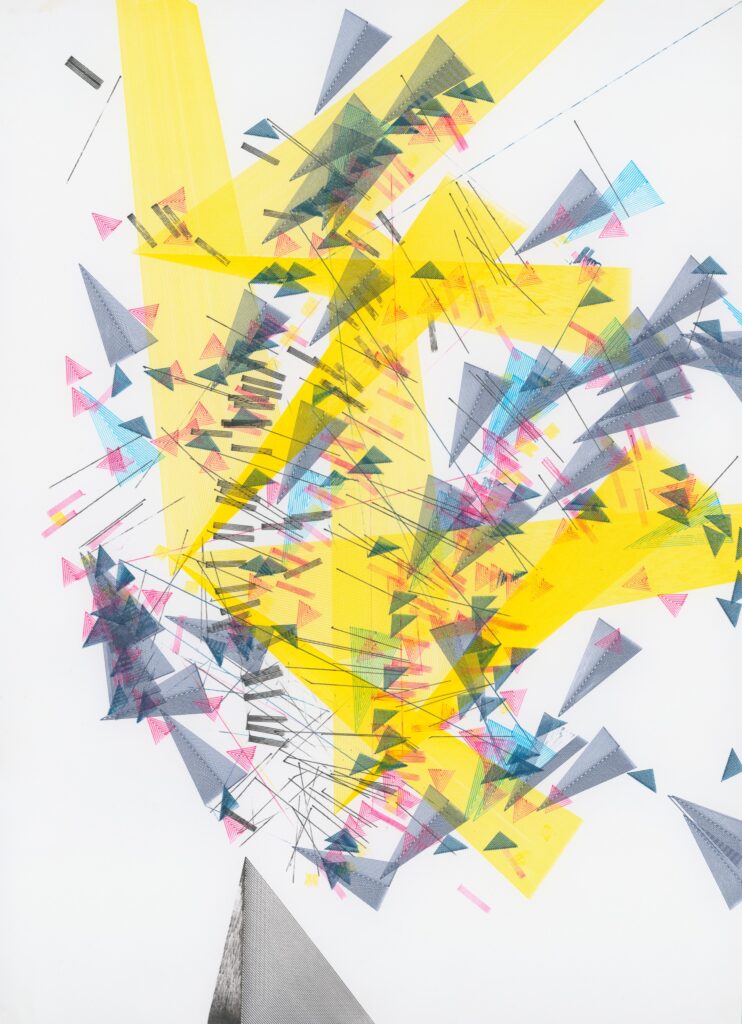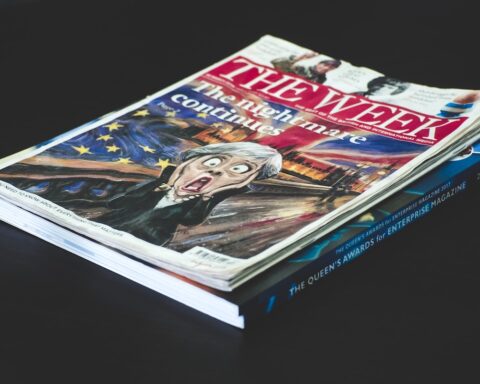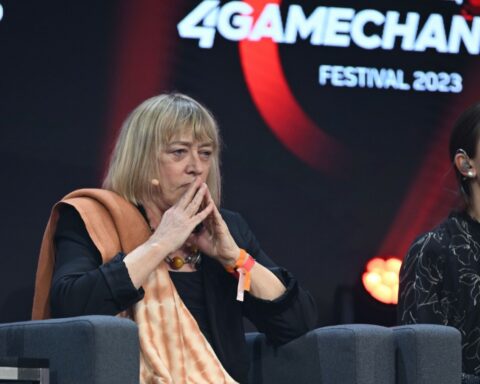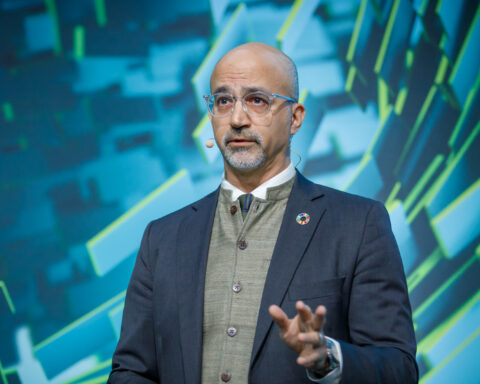Can robots create art? Expecting a robot to be capable of creativity may seem like something out of a science-fiction film. However, for Liz Melchor, the concept is far from mind-boggling. That is because she quite literally draws with robots.
We meet at her art studio in Vienna, a city Melchor now calls home. After handing me a cup of coffee, the San Francisco native shares the unexpected way that she ended up in a niche community that blends art, coding, and engineering. A decade ago, Melchor had been working as a journalist, with her work featured in the likes of The Washington Post and The Guardian. To improve her writing skills, she signed up for a drawing course. (“It was all about the creative process,” she says.) Describing herself as a math-lover since childhood, Melchor discovered “this whole little world” of drawing with robots during the pandemic. Ever since then, she says she grew “really, really obsessed” with computer programming for art. This would lead her to dive into creative coding and even engineering, with her eventually building her own robot.

Her studio is everything and more you’d expect from someone exploring the intersection of art and technology. There’s a large desktop computer and a laptop. There’s a 3D printer in the corner, which hums as it weaves together an electric blue plastic pot. Beside is a large shelf stacked with artbooks, many of them featuring the work of fellow ‘tinkerers’ who also get creative with tech. And then, of course, almost centrestage in her studio, in all its glory, stands the robot.
Or to be more precise, it is a pen plotter machine.
While the name may not sound too cool, the way the machine works certainly is cool. It essentially looks like a large, flat surface where paper is put, which is fitted with an ‘arm’ that holds a pen or paper. This arm then moves that particular instrument horizontally and vertically across the sheet of paper, thereby enabling the machine to draw. What exactly the pen plotter draws depends on the instructions that Melchor enters into her computer via coding. The machine will then follow these commands with incredible accuracy. The fact that pen plotters can draw with such precision means that they are commonly used to print maps or architectural blueprints.

However, perfection isn’t what appeals to Melchor. Instead, her work is ‘in search of surprise’. Errors or glitches in her experiments are welcome. She intentionally uses techniques so that each pen plotter drawing is different. This includes dousing water on the paper and using other unpredictable materials. As she explains, “I can tell the robot to do the exact same steps on 10 different papers, and they will all look different because of the way that the water ends up on the page, which is completely random.”
But not everyone seems exactly thrilled about Melchor’s artwork. Roughly a year before our meeting, she unwittingly created a storm online after posting an Instagram reel about her latest pen plotter antics. The clip had shown a robot drawing with a bright red ink pen on paper which was scattered with water droplets. The pen ink eventually fuses with the water, creating the appearance of flowing blood. Combined with the eerie background music, the video gives off sinister, dystopian vibes. Melchor had intended for the reel to be ‘gimmicky’— however, she ended up getting a lot more than she bargained for.
Within mere hours, her video went viral, eventually gaining over 40 million views and more than 700,000 likes. As the views grew, so did the comment section as more members of the public waded into the discussion. Some applauded her creativity, but others were less pleasant. Several commentators called Melchor’s artwork ‘crap’ or ‘shit’. One comment under that fateful social media post — which has now gained almost 800 likes — states in seeming disapproval that “now days [sic] evrything [sic] is art.”
What exactly was all the fuss about? The former journalist suggests that various factors may have been at play. For one, she partly puts it all down to being “an internet thing.” Indeed, in this current age of social media, the ability to offend seems so easy, with even the most trivial things able to unleash a torrent of outrage online. However, in her opinion, the main thread of objection was that none of her work could be considered art because it had not been directly created by a human, but by a machine. There’s also suspicion that much of this hostility may stem from concerns about AI’s rising influence. Indeed, she does wonder whether many people confuse the abbreviation as standing for ‘autonomous intelligence’, instead of actually ‘artificial intelligence’.
As the artist puts it, “we’re scared that AI or machines are going to become these completely autonomous things and then will take over people’s jobs or that machines are going to take over us.” With hindsight, she also believes that the human blood-like red ink in the video may have also triggered some people, perhaps arousing a sense of impending doom as the robots rise up against humans. According to her, some may view AI’s growing influence in the art scene as particularly uncomfortable because art, and indeed creative expression as a whole “feel like the most human thing”. She adds that there may be fears about such a new tool changing the art world and therefore leaving other artists at a disadvantage.
I’m curious how the artist will respond to all of this. First, Melchor addresses some key misunderstandings. For one, she does not actually create any of her artwork with AI. But, she thinks a lot of people nonetheless still associate her robots with the technology. Secondly, pen plotters are not a brand new invention. As she explains, they’re actually “quite old” and have been around since the 1960s. The artist goes on to argue that “there’s so much art that is not made directly with one’s hands”. She notes that humans have been using various tools for years to realise their artistic visions, citing cameras and even the humble paintbrush as key examples. Melchor concludes “I view the machines as tools in the same way.”

While we are on the subject, I cannot help but want to dig deeper into Melchor’s feelings on AI increasingly getting into the picture (pun very much intended). After all, the conversation on AI’s impact on art has grown all the more heated in recent years given the launch of online platforms like DALL-E and Midjourney. The abilities of such AI image-generators to spew out a picture based on a few prompts have blown the minds of many but also sparked concerns about copyright infringements and the future livelihoods of artists being at stake. In some ways, Melchor seems to find herself in quite a strange position amid all this commotion. A woman who has been experimenting with the intersection of tech and art for the past two years. A person who hails from the Bay Area — an AI powerhouse — and is now based in a city famous for its fine art museums and producing the likes of Gustav Klimt and Egon Schiele.
But her answer isn’t what I expected. For a start, while the Californian acknowledges that we could kick off a whole debate about ‘what is art?’, she thinks it is “uninteresting” to decide what should or should not qualify as art. The point seems reasonable given that the answer will always be very subjective. According to her, it seems more appropriate to ask “is it interesting to me?”
Likewise, Melchor appears neither particularly excited nor threatened about AI-generated art. While there’s a recognition of the serious copyright issues and that the jobs of designers could be on the line, she does not find such artwork very engaging. As she explains, “you feed [the AI platform] a prompt and it gives you something, but that’s it. That’s the end of the interaction.” Not only does Melchor describe this as “no fun”, but she is also missing the challenge and unpredictability. In her view, “art comes out of a wrestle.” In other words, a messy struggle where you don’t know what you will get out of the process. This is exactly what she says she is trying to explore with robots.
It is also this creative wrestling which Melchor believes has the power to move us emotionally — something which she doubts AI can achieve. As she puts it “could AI ever write something like Moby Dick? Could it make beautiful art that touches people in a tender way that makes them stop and feel something? I don’t think so.”
But, she is also careful not to rule anything out: “Prove me wrong … I’m super open to having my mind changed”. It seems like a very fitting response from an artist who is in search of the unexpected.





